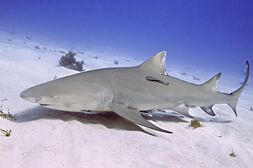القرش المكشر
| Requiem sharks | |
|---|---|
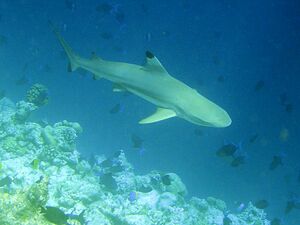
| |
| Blacktip reef shark, Carcharhinus melanopterus | |
| التصنيف العلمي | |
| أصنوفة غير معروفة (أصلحها): | Carcharhinidae |
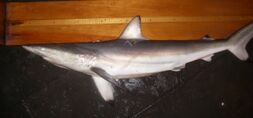
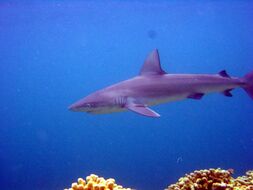
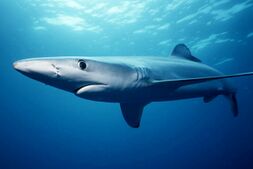
Requiem sharks are sharks of the family Carcharhinidae in the order Carcharhiniformes. They are migratory, live-bearing sharks of warm seas (sometimes of brackish or fresh water) and include such species as the bull shark, lemon shark, blacktip shark, and whitetip reef shark.
Family members have the usual carcharhiniform characteristics. Their eyes are round, and one or two gill slits fall over the pectoral fin base. Most species are viviparous, the young being born fully developed. They vary widely in size, from as small as 69 cm (2.26 ft) adult length in the Australian sharpnose shark, up to 4 m (13 ft) adult length in the oceanic whitetip shark.[1] Scientists assume that the size and shape of their pectoral fins have the right dimensions to minimize transport cost.[2] Requiem sharks tend to live in more tropical areas, but tend to migrate. Females release a chemical in the ocean in order to let the males know they are ready to mate. Typical mating time for these sharks is around spring to autumn.[3]
According to the ISAF, requiem sharks are among the top five species involved in shark attacks on humans;[4] however, "requiem shark" is not a single species, but refers, in this case, to an order of similar sharks that are often involved in incidents. ISAF prefers to use "requiem sharks" due to the difficulty in identifying individual species.[5]
. . . . . . . . . . . . . . . . . . . . . . . . . . . . . . . . . . . . . . . . . . . . . . . . . . . . . . . . . . . . . . . . . . . . . . . . . . . . . . . . . . . . . . . . . . . . . . . . . . . . . . . . . . . . . . . . . . . . . . . . . . . . . . . . . . . . . . . . . . . . . . . . . . . . . . . . . . . . . . . . . . . . . . . .
Etymology
The common name requiem shark may be related to the French word for shark, requin, which is itself of disputed etymology. One derivation of the latter is from Latin requiem ("rest"), which would thereby create a cyclic etymology (requiem-requin-requiem), but other sources derive it from the Old French verb reschignier ("to grimace while baring teeth").
The scientific name Carcharhinidae was first proposed in 1896 by D.S. Jordan and B.W. Evermann as a subfamily of Galeidae (now replaced by "Carcharhinidae").[6][7] The term is derived from Greek κάρχαρος (karcharos, sharp or jagged), and ῥί̄νη (rhinē, rasp); both elements describe the jagged, rasp-like skin.[8] Rasp-like skin is typical of shark skin in general, and is not diagnostic to Carcharhinidae.
Evolutionary history
The oldest member of the family is Archaeogaleus lengadocensis from the Early Cretaceous (Valanginian) of France.[9] Only a handful of records of the group are known from prior to the beginning of the Cenozoic.[10] Modern carcharinid sharks have extensively diversified in coral reef habitats.[11]
Hunting strategies
Requiem sharks are extraordinarily fast and effective hunters. Their elongated, torpedo-shaped bodies make them quick and agile swimmers, so they can easily attack any prey. Some species are continually active, while others are capable of resting motionless for extended periods on the bottom. They have a range of food sources depending on location and species, including bony fish, squid, octopus, lobster, turtles, marine mammals, seabirds, other sharks and rays; smaller species tend to select a narrow range of prey, but some very large species, especially the tiger shark (Galeocerdo cuvier), are virtually omnivorous.[7] They are often considered the "garbage cans" of the seas because they will eat almost anything, even non-food items like trash.[7] They are migratory hunters that follow their food source across entire oceans. They tend to be most active at night time,[7] where their impressive eyesight can help them sneak up on unsuspecting prey. It is worth mentioning that the tiger shark, however, possibly belongs to the Galeocerdidae family.[12] Most requiem sharks hunt alone, however some species like the whitetip reef sharks and lemon sharks are cooperative feeders and will hunt in packs through coordinated, timed attacks against their prey. Some of the species have been shown to give specialized displays when confronted by divers or other sharks, which may be indicative of aggressive or defensive threat.[7]
Classification
The 59 species of requiem shark are grouped into 11 genera:[1]
- Genus Scoliodon J. P. Müller & Henle, 1838
- Scoliodon laticaudus J. P. Müller & Henle, 1838 (spadenose shark)
- Scoliodon macrorhynchos Bleeker, 1852 (Pacific spadenose shark)
- Genus Carcharhinus Blainville, 1816
- Carcharhinus acronotus Poey, 1860 (blacknose shark)

- Carcharhinus albimarginatus Rüppell, 1837 (silvertip shark)
- Carcharhinus altimus S. Springer, 1950 (bignose shark)
- Carcharhinus amblyrhynchoides Whitley, 1934 (graceful shark)
- Carcharhinus amblyrhynchos Bleeker, 1856 (grey reef shark)
- Carcharhinus amboinensis J. P. Müller & Henle, 1839 (pigeye shark)
- Carcharhinus borneensis Bleeker, 1858 (Borneo shark)
- Carcharhinus brachyurus Günther, 1870 (copper shark)
- Carcharhinus brevipinna J. P. Müller & Henle, 1839 (spinner shark)

- Carcharhinus cautus Whitley, 1945 (nervous shark)
- Carcharhinus cerdale C. H. Gilbert, 1898 (Pacific smalltail shark)
- Carcharhinus coatesi Whitley, 1939 (Coates's shark)
- Carcharhinus dussumieri J. P. Müller & Henle, 1839 (whitecheek shark)
- Carcharhinus falciformis J. P. Müller & Henle, 1839 (silky shark)

- Carcharhinus fitzroyensis Whitley, 1943 (creek whaler)
- Carcharhinus galapagensis Snodgrass & Heller, 1905 (Galapagos shark)
- Carcharhinus hemiodon J. P. Müller & Henle, 1839 (Pondicherry shark)
- Carcharhinus humani W. T. White & Weigmann, 2014 (Human's whaler shark)
- Carcharhinus isodon J. P. Müller & Henle, 1839 (finetooth shark)
- Carcharhinus leiodon Garrick, 1985 (smoothtooth blacktip shark)
- Carcharhinus leucas J. P. Müller & Henle, 1839 (bull shark)

- Carcharhinus limbatus J. P. Müller & Henle, 1839 (blacktip shark)

- Carcharhinus longimanus Poey, 1861 (oceanic whitetip shark)

- Carcharhinus macloti J. P. Müller & Henle, 1839 (hardnose shark)
- Carcharhinus melanopterus Quoy & Gaimard, 1824 (blacktip reef shark)
- Carcharhinus obscurus Lesueur, 1818 (dusky shark)

- Carcharhinus perezi Poey, 1876 (Caribbean reef shark)
- Carcharhinus plumbeus Nardo, 1827 (sandbar shark)

- Carcharhinus porosus Ranzani, 1839 (smalltail shark)
- Carcharhinus sealei Pietschmann, 1913 (blackspot shark)
- Carcharhinus signatus Poey, 1868 (night shark)
- Carcharhinus sorrah J. P. Müller & Henle, 1839 (spot-tail shark)

- Carcharhinus tilstoni Whitley, 1950 (Australian blacktip shark)
- †Carcharhinus tingae[13]
- Carcharhinus tjutjot Bleeker, 1852 (Indonesian whaler shark)
- Carcharhinus obsolerus White, Kyne, and Harris, 2019 (lost shark)
- Carcharhinus acronotus Poey, 1860 (blacknose shark)
- Genus Glyphis Agassiz, 1843
- Glyphis gangeticus J. P. Müller & Henle, 1839 (Ganges shark)
- Glyphis garricki Compagno, W. T. White & Last, 2008 (northern river shark)
- Glyphis glyphis J. P. Müller & Henle, 1839 (speartooth shark)
- Glyphis sp. not yet described (Mukah river shark)
- Genus Lamiopsis Gill, 1862
- Lamiopsis temminckii J. P. Müller & Henle, 1839 (broadfin shark)
- Lamiopsis tephrodes Fowler, 1905 (Borneo broadfin shark)
- Genus Nasolamia Compagno & Garrick, 1983
- Nasolamia velox C. H. Gilbert, 1898 (whitenose shark)
- Genus Negaprion Whitley, 1940
- Negaprion acutidens Rüppell, 1837 (sicklefin lemon shark)
- Negaprion brevirostris Poey, 1868 (lemon shark)

- †Negaprion eurybathrodon Blake, 1862
- Genus Prionace Cantor, 1849
- Prionace glauca Linnaeus, 1758 (blue shark)
- Genus Rhizoprionodon Whitley, 1929
- Rhizoprionodon acutus Rüppell, 1837 (milk shark)
- Rhizoprionodon lalandii J. P. Müller & Henle, 1839 (Brazilian sharpnose shark)
- Rhizoprionodon longurio D. S. Jordan & C. H. Gilbert, 1882 (Pacific sharpnose shark)
- Rhizoprionodon oligolinx V. G. Springer, 1964 (grey sharpnose shark)
- Rhizoprionodon porosus Poey, 1861 (Caribbean sharpnose shark)
- Rhizoprionodon taylori Ogilby, 1915 (Australian sharpnose shark)
- Rhizoprionodon terraenovae J. Richardson, 1836 (Atlantic sharpnose shark)
- Genus Loxodon J. P. Müller & Henle, 1838
- Loxodon macrorhinus J. P. Müller & Henle, 1839 (sliteye shark)
- Genus Isogomphodon Gill, 1862
- Isogomphodon oxyrhynchus J. P. Müller & Henle, 1839 (daggernose shark)
- Genus Triaenodon J. P. Müller & Henle, 1837
- Triaenodon obesus Rüppell, 1837 (whitetip reef shark)
- Genus †Physogaleus Cappetta, 1980[14]
- †Physogaleus americanus Case, 1994
- †Physogaleus contortus Gibbes, 1849
- †Physogaleus hemmooriensis Reinecke & Hoedemakers, 2006
- †Physogaleus huberensis Case, 1981
- †Physogaleus latecuspidatus Muller, 1999
- †Physogaleus latus Storms, 1894
- †Physogaleus maltzani Winkler, 1875
- †Physogaleus onkensis Boulemia & Adnet, 2023
- †Physogaleus rosehillensis Case & Borodin, 2000
- †Physogaleus secundus Winkler, 1876
- †Physogaleus tertius Winkler, 1876
† = extinct
انظر أيضاً
. . . . . . . . . . . . . . . . . . . . . . . . . . . . . . . . . . . . . . . . . . . . . . . . . . . . . . . . . . . . . . . . . . . . . . . . . . . . . . . . . . . . . . . . . . . . . . . . . . . . . . . . . . . . . . . . . . . . . . . . . . . . . . . . . . . . . . . . . . . . . . . . . . . . . . . . . . . . . . . . . . . . . . . .
المراجع
- ^ أ ب Compagno, L.J.V. Family Carcharhinidae - Requiem sharks in Froese, R. and D. Pauly. Editors. 2010. FishBase. World Wide Web electronic publication, version (10/2013).
- ^ Iosilevskii, G.; Papastamatiou, Y. P. (2016). "Relations between morphology, buoyancy and energetics of requiem sharks". Royal Society Open Science. 3 (10): 160406. Bibcode:2016RSOS....360406I. doi:10.1098/rsos.160406. PMC 5098981. PMID 27853556.
- ^ "Introducing Requiem Sharks". 22 August 2016.
- ^ "Species Implicated in Attacks". Florida Museum. 24 January 2018. Retrieved 2 June 2018.
- ^ ISAF Statistics on Attacking Species of Shark Archived يوليو 24, 2009 at the Wayback Machine
- ^ Subfamily Carcharhininae Jordan & Evermann, 1896 (Family Galeidae), Bull.U.S.Nat.Mus., 48(1):28.
- ^ أ ب ت ث ج Compagno 1984, p. 445.
- ^ Scharpf, Christopher; Lazara, Kenneth J. (18 January 2013). "Order Carcharhiniformes (Ground Sharks): Families Pentanchidae, Scyliorhinidae, Proscylliidae, Pseudotriakidae, Leptochariidae, Triakidae, Hemigaleidae, Carcharhinidae and Sphyrnidae". The ETYFish Project. Retrieved July 31, 2021.
- ^ Guinot, Guillaume; Cappetta, Henri; Adnet, Sylvain (March 2014). "A rare elasmobranch assemblage from the Valanginian (Lower Cretaceous) of southern France". Cretaceous Research (in الإنجليزية). 48: 54–84. Bibcode:2014CrRes..48...54G. doi:10.1016/j.cretres.2013.11.014.
- ^ Gates, Terry A.; Gorscak, Eric; Makovicky, Peter J. (2019-01-22). "New sharks and other chondrichthyans from the latest Maastrichtian (Late Cretaceous) of North America". Journal of Paleontology. 93 (3): 512–530. Bibcode:2019JPal...93..512G. doi:10.1017/jpa.2018.92. ISSN 0022-3360. S2CID 198159821.
- ^ Sorenson, L.; Santini, F.; Alfaro, M. E. (August 2014). "The effect of habitat on modern shark diversification". Journal of Evolutionary Biology (in الإنجليزية). 27 (8): 1536–1548. doi:10.1111/jeb.12405. PMID 24890604.
- ^ Pollerspöck, J.; Straube, N. Bibliography Database of Living/Fossil Sharks, Rays and Chimaeras (Chondrichtyes: Elasmobranchii, Holocephali)—List of Valid Extant Species; List of Described Extant Species; Statistic, World Wide Web Electronic Publication, Version 10/2021; ISSN 2195-6499. Available online: www.shark-references.com (accessed on 23 November 2021).
- ^ "Extinct shark named after LSU museum official as she retires". Washington Post (in الإنجليزية الأمريكية). ISSN 0190-8286. Retrieved 2021-12-25.
- ^ D. J. Cicimurri, J. L. Knight, J. A. Ebersole (March 2022). "Early Oligocene (Rupelian) fishes (Chondrichthyes, Osteichthyes) from the Ashley Formation (Cooper Group) of South Carolina, USA". PaleoBios. 39 (1): 1–38. doi:10.5070/P939056976.
{{cite journal}}: CS1 maint: multiple names: authors list (link)
المصادر
Compagno, Leonard J.V. (1984). FAO species catalogue Vol.4. Sharks of the world. An annotated and illustrated catalogue of shark species known to date. Part 2. Carcharhiniformes (PDF). Rome: Food and Agriculture Organization of the United Nations. ISBN 9251013837.
